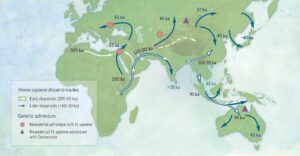
PROCEEDINGS OF THE NATIONAL ACADEMY OF SCIENCES—A study finds a link between the strengthening of the Asian summer monsoon and early human migration out of Africa to East Asia during the last interglacial period. The role of climate shifts in shaping early Homo sapiens dispersal to East Asia is an important aspect of human history. However, the subject remains underexplored due to a lack of coordinated paleoclimate and paleoanthropological data. Hong Ao, Jiaoyang Ruan, and colleagues combined records of the Asian summer monsoon from the Chinese Loess Plateau with models of East Asian paleoclimate, compilations of paleoanthropological data, and simulations of Homo sapiens habitat suitability. The resulting reconstruction covers the last 280,000 years and connects the orbital-scale influences on Asian summer monsoon dynamics with early human dispersal. The results suggest that the Asian summer monsoon is influenced by Northern Hemisphere ice volume, greenhouse gas concentrations, and summer solar radiation. The monsoon strengthened between 125,000 and 70,000 years ago, increasing temperatures and precipitation across Asia. The monsoon strengthening coincides with the earliest fossil H. sapiens specimens at multiple locations in Asia. According to the authors, the strengthening of the Asian summer monsoon, along with a coincident deterioration of the climate in Southeast Africa, may have spurred the dispersal of early humans from Africa into East Asia.
____________________________

Map showing the early (pre-LGM) dispersal of Homo sapiens, 200,000 to 32,000 years ago. Katerina Douka & Michelle O’Reilly, Michael D. Petraglia, CC-BY-SA 4.0, Wikimedia Commons
____________________________
Article Source: PNAS news release
*“Concurrent Asian monsoon strengthening and early modern human dispersal to East Asia during the last interglacial,” by Hong Ao et al., Proceedings of the National Academy of Sciences, 8-Jan-2024. https://www.pnas.org/cgi/doi/10.1073/pnas.2308994120
____________________________
Advertisement

See the incredible archaeology, architecture, and art of northern Spain. A unique tour with special expert guides and lecturers through the collaboration of Popular Archaeology Magazine and Stone & Compass Tours. Not to be missed. Read More About It: https://popular-archaeology.com/article/northern-spains-triple-a-archaeology-architecture-and-art/.
____________________________




